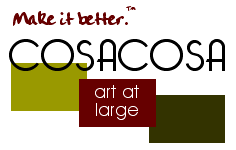



The ensuing cultural tensions and dislocations -- in the Middle East and in other regions less notorious -- inevitably boil over into economic and political arenas. Still, world governments and institutions conditioned by traditional attitudes persist in dealing with change by addressing economic, military or political issues without acknowledging or responding to perceptual and cultural problems which so often are the underlying cause of tension and conflict.
At the risk of oversimplification, it is not too much to say that society's most pressing task is to find remedies for the disorientation caused by global change. In past ages the unifying ideas that served to stabilize societies were found in art, religion and mythology; but in the modern era these fertile sources of order and orientation have been displaced from their traditional role, and altered or severely devalued. And precisely because our era is so markedly different from any in the past -- and because its problems and challenges are so totally unprecedented -- it is clear that ways must be found to prepare for what is virtually a new human environment on this planet.
Still, no new age ever began with so much creative potential or with so many powerfully communicative tools as we now possess for tapping the collective resources of humankind. No civilized society ever possessed anything like our current ability to retrieve and review the great lessons of history, or to scan so clearly the daily events of the present, or to project our designs so effectively forward into the future. Yet, as so much of our literature, art and cinema ominously portends, the hardware of the information environment has the potential to be mindless, amoral, dehumanizing and even harmful. Indeed, the true test will be whether the information age is ultimately used to multiply mankind's creative options or whether it will foster a global uniformity that threatens to extinguish the independent imagination. In either event, creativity in all its aspects remains the best insurance against the specter of a human existence that is fragmented and disoriented. In an era when millions of lives can be cut loose from their cultural moorings, purposeful human creativity -- which must include the visionary as well as the merely informative -- will have to be mobilized to respond to the challenges of change.
Perhaps we can think of the arts as a kind of software for the information society. Alone among all human endeavors, the arts are both the treasury of our past and the expressive edge of the present. Just as the arts of the past continue to provide the world's cultures with repositories of historical beliefs, concepts and aspirations, the art of our own time reveals the truth of the present -- while it projects a perceptual pathway into the future. Throughout history, the real purpose of art has been to reveal those things -- perceptual, moral and ethical -- that no culture can live without. Our society would do well to recognize the power for good that living artists represent because, first, the artist's methodology of thinking and seeing can contribute powerfully to non-artistic endeavors; and, second, because art itself builds bridges of comprehension between peoples, cultures and nations. The arts are free to cross perceptual boundaries and explore the risky and the new, offering innumerable options for individuals and societies threatened with cultural disorientation.
Our society must explore a more profound understanding of the fundamental transformations taking place in human perceptions, attitudes and beliefs. It is essential that we recognize the impact of change on the cultural values of individuals, groups and nations. We need to know more about how culture is organized, transmitted and produced, and more about the impact of information flow and communications of the concept of culture itself. Art, as cultural software, will play a critical role in helping us to understand the complex phenomena that affect, create and modify social issues in our time.
John A. Clauser (1938-2002) was the Founding Director of the Yellow Springs Institute, an international residency center for artists and scholars. This excerpt is from an essay originally published in the Yellow Springs Review, fall 1984; volume 1, #2. A comprehensive archive and data base -- documenting the Institute's over twenty years of interdisciplinary art, ideas and dialogues -- is nearing completion and will be donated to an appropriate research institution in his memory.